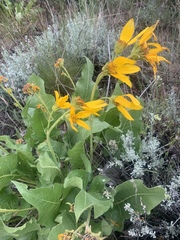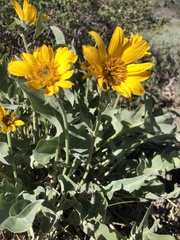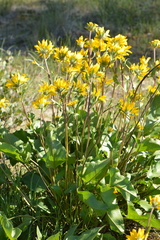The "arrow-leaved" balsamroots in Central Oregon
This is part of a series of Central Oregon plant ID notes; find the others here.
Summary
There are three species of balsamroot (Balsamorhiza spp.) with simple leaves and flat to notched leaf bases in or near Central Oregon. Carey's balsamroot (B. careyana) is most common in the east Cascades. It can be recognized by (usually) having stems with one large flower head and multiple smaller lateral heads, leaves that are hirsute (with short stiff straight hairs), and ray florets that persist on the seed after drying. Arrowleaf balsamroot (B. sagittata) is more common to the east in the lava plains and Ochoco Mountains. It is recognized by (usually) having a single flower head on each stem, densely tomentose (woolly with matted hairs) phyllaries (the bracts surrounding the flower head), and tomentose leaves, particularly on the undersides. Deltoid balsamroot (B. deltoidea) grows mainly west of the Cascade crest, but enters our area near the crest where it intergrades with Carey's balsamroot. It has stems with a single terminal flower head and maybe 1 or two smaller lateral heads, has leaves that are sparsely hirsute, and may have rounded teeth on the leaf margins. Balsamroots are notorious for hybridizing where species overlap, so it is often difficult to assign an individual plant to a species.
Introduction
Balsamroots (genus Balsamorhiza) are among our most showy wildflowers, with large basal leaves and tall stems with large yellow sunflower-like heads. There are 12 species of balsamroots in western North America, of which 3 have large arrow-shaped leaves (Balsamorhiza section Artorhiza) (FNA*), and all 3 of those species are found in or near Central Oregon (FoO/OFP*). The three species are Carey's balsamroot (B. careyana), arrowleaf balsamroot (B. sagitatta) and deltoid balsamroot (B. deltoidea). These species are sometimes difficult to tell apart, and may hybridize where their ranges overlap.
Species descriptions
See the Key Characteristics section for detailed distinguishing features.
Carey's balsamroot (B. careyana)
| Carey's balsamroot, from Observation 47946776 | Distribution on iNaturalist |
 |
Carey's balsamroot is recognizable by having green leaves with few short, coarse hairs and usually entire margins, usually having multiple flower heads on each stem, and having ray flowers that persist on the heads after drying. This species occurs mainly on the east slope of the Cascades and the Columbia Plateau from central Oregon to north-central Washington.
Arrowleaf balsamroot (B. sagittata)
| Arrowleaf balsamroot, from Observation 52336715 | Distribution on iNaturalist |
 |
Arrowleaf balsamroot is recognizable by having woolly grey leaves (sometimes only the lower surface of young leaves), usually single flower heads on each stem, and densely woolly phyllaries (bracts below the flower head). This species occurs throughout the intermountain region between the Cascades/Sierra Nevada and the Rocky Mountains from southern British Columbia south to California and Arizona.
Deltoid balsamroot (B. deltoidea)
| Deltoid balsamroot, from Observation 24287450 | Distribution on iNaturalist |
 |
Deltoid balsamroot is recognizable by having green leaves with few short, coarse hairs and wavy or toothed margins, one to several flower heads per stem, and ray flowers that fall as the head matures. The species primarily occurs west of the Cascades & Sierra Nevada from southern Vancouver Island to southern California. It approaches our area near the Cascade crest, in the Columbia River Gorge, and near the marshes of Klamath and Lake Counties.
Key characteristics
Based on consulting three recent floras: Flora of North America (FNA); Flora of the Pacific Northwest, 2nd ed. (FPNW2); Flora of Oregon, vol. 2 (FoO, OFP). Note that these floras disagree on some of the distinguishing characters, making this a very difficult group indeed.
Inflorescence
No. of heads per stem
- careyana — us. 3+, occ. 2 (FNA); several, ca. equal (FPNW2); 1 large, 1-6 smaller (FoO)
- sagittata — us. 1, occ. 2-3+ (FNA); 1, occ. 2-3 (FPNW2); 1 large, rarely 1-3 smaller (FoO)
- deltoidea — us. 1, occ. 2+ (FNA); several, lateral heads smaller (FPNW2); 1 large, 0-2 smaller (FoO)
Phyllaries (bracts below the heads)
- careyana — slightly or scarcely woolly (FPNW2); villous (with long, soft, unmatted hairs) to tomentose (with matted or tangled hairs)
- sagittata — generally woolly-tomentose (FPNW2); densely tomentose, esp. at base (FoO)
- deltoidea — slightly or scarcely woolly (FPNW2); villous, more densely at bases (FoO)
Ray Flowers: persistence
- careyana — "tardily deciduous, tending to persist on the achene and become +/- papery" (FPNW2); persistent after drying (FoO)
- sagittata — (no mention of deciduous vs persistent in any of the sources)
- deltoidea — early deciduous, not becoming papery (FPNW2); deciduous (FoO)
Leaves
Leaf margins
- careyana — entire, occ. crenate (wavy) to dentate (toothed) near base (FNA, FoO)
- sagittata — entire (FoO)
- deltoidea — crenate to dentate near base (FNA); entire to toothed, teeth rounded and apiculate (FoO)
Leaf surface
- careyana — green with few coarse hairs (FPNW2); with fine stiff hairs and gland-dotted (FNA); with fine stiff hairs (FoO)
- sagittata — silvery with feltlike wool when young, esp. lower surface (FPNW2); variously woolly (at least lower surface), sometimes nearly hairless, usually gland-dotted as well (FNA); surfaces woolly, more densely so on lower surface (FoO)
- deltoidea — green with few coarse hairs (FPNW2); usually with fine stiff hairs, sometimes not, usually gland-dotted (FNA); sparsely stiff-hairy on upper surface veins (FoO)
Sources
FNA: Flora of North America (online), http://beta.floranorthamerica.org
FoO: Meyers, SC, et al. (2015, 2020, 2022?) Flora of Oregon. BRIT press (3 vols. planned)
OFP: Oregon Flora Project, https://oregonflora.org, the online companion to FoO
FPNW2: Hitchcock, CL, and Cronquist, A (2018) Flora of the Pacific Northwest, 2nd edition. Univ. Washington Press




